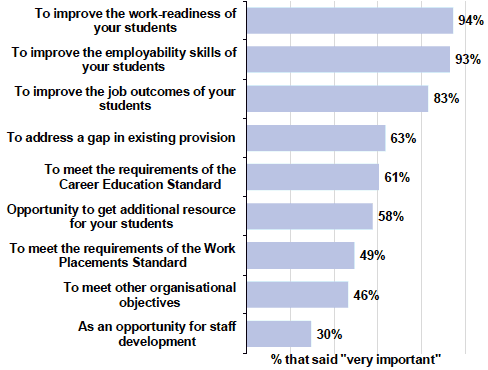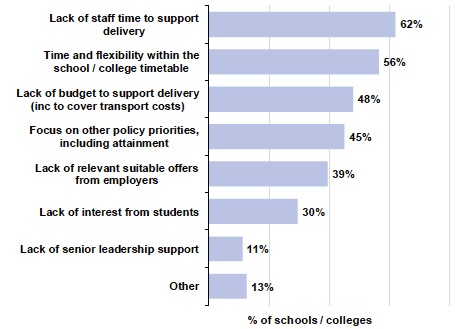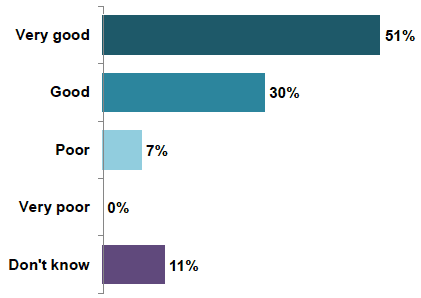Developing the Young Workforce (DYW) regional groups: formative evaluation
External evaluation to examine the early operations of four of the most established Developing the Young Workforce (DYW) regional groups. The study was carried out between December 2017 and April 2018.
7. Engaging schools / colleges
Chapter Summary
- Schools and colleges reported similar motivations to employers for engaging in DYW activities.
- These mainly focused on improving the life chances of young people through developing their work-readiness, employability and job outcomes, rather than meeting statutory obligations.
- Schools and colleges reported a number of barriers to engaging with employers, including a lack of resources (time and budget), timetabling issues and competing policy priorities.
- Feedback from schools and colleges on the quality of the activities delivered through the Regional Groups was very positive. Several also commented on the enthusiasm, commitment and professionalism of the DYW staff teams.
- Potential areas for improvement highlighted by schools / colleges include better targeting of hard-to-reach students, more opportunities to share best practice, increased resources for schools to deliver.
Introduction
7.1 Engagement of schools is fundamental to the success of the Regional Groups – schools play a vital role in identifying young people who would benefit from increased encounters with employers and experiences of workplaces. Regional Groups need to build effective relationships with schools and colleges to identify the needs of their students and to connect them with suitable employers who can offer appropriate support.
7.2 This Chapter details the nature of school and college engagement with the DYW Regional Groups. It explores schools' motivations for engagement, the nature of their engagement, barriers faced and levels of satisfaction with their experiences to date.
Motivations for engagement
Schools were motivated to engage with DYW to increase opportunities for their students, rather than to meet individual, organisational or statutory objectives.
7.3 Schools reported very similar motivations to employers for engaging in DYW activities (Figure 7‑1). These were most often focused on improving the life chances of young people through developing their work-readiness, employability and job outcomes. They were less often driven by the statutory obligations of meeting the Career Education Standard and the Work Placement Standard and also less motivated by individual or organisational objectives.
7.4 Two thirds of schools were motivated to address a gap in existing provision. This suggests that one in three did not recognise that they had a gap in provision before engagement. This was discussed in the regional workshops and in consultations with school representatives. It was reported that some schools that had not engaged with DYW activity had existing connections with employers established through parents or teachers, or through students approaching employers directly.
Figure 7‑1: How important are the following factors as motivators for your school / college to engage in DYW activities?

Source: SQW school survey March 2018
Base: 71 schools/colleges
Barriers to engagement
Schools reported facing a number of barriers and challenges to engaging with employers such as a lack of staff time, timetabling issues and a lack of resources.
7.5 Schools were asked whether their organisation had experienced any barriers or challenges to engagement. Of the 71 respondents, just four (5% of the total) stated that they had not experienced any barriers to engagement. This can be contrasted to the results from the employer survey, where 38% of respondents had not faced any barriers to engagement.
7.6 Figure 7-2 shows the barriers / challenges to engagement faced by the remaining 67 survey respondents. This shows that:
- Almost two thirds cited a lack of staff time to support delivery
- More than half cited time and flexibility within the school / college timetable as a key barrier
- Around half reported a lack of budget to support delivery
- A focus on attainment and other policy priorities. The barriers faced by schools are set out in
7.7 Other barriers cited in the open responses to the survey include buy-in from parents and senior leaders within schools.
Figure 7‑2: Has your organisation experienced any of the following barriers / challenges to engaging with DYW activities? Select all that apply

Source: SQW school survey March 2018
Base: 68 schools/colleges
7.8 Discussion in two of the regional workshops explored a lack of interest from students as a barrier faced by schools to engaging in DYW activities. One possible explanation put forward for this was that young people were confident that they would find a job after leaving school, particularly in a tight labour market and with a broad range of support available through various funded initiatives. The consensus was that there was an important role for teachers to "sell" the benefits of engagement to young people, for example in terms of job quality.
7.9 It was evident from the consultations that many schools found it difficult to isolate the specific contribution of the DYW Regional Groups from the wider DYW programme, with at least one consultee reporting that they were unaware of the existence of a "Regional Group" despite having engaged with them directly. This raises questions about the division of DYW activities between Regional Groups and local authorities, and the visibility of the Regional Groups within schools. Although, this could be viewed as a positive thing as it suggests that the Regional Groups are integrating well with the range of other services available, although it does make evaluation of individual strands of activity more difficult.
Feedback on effectiveness
Schools were satisfied with the quality of the activities delivered through engagement with the Regional Group
7.10 Most (81%) of schools / colleges that responded to the survey rated the quality of activities engaged with through the DYW Regional Groups as good or very good (Figure 7-3).
Figure 7‑3: Overall, how would you rate the quality of the activities delivered following your engagement with the Regional Group for your students?

Source: SQW school survey March 2018
Base: 70 schools/colleges
Respondents were satisfied with the networks, commitment, and professionalism of the Regional Groups.
7.11 Survey respondents (n=34) cited a number of success factors associated with the work of the Regional Groups. In particular, they highlighted:
The importance of enthusiasm from all parties – schools, employers and Regional Group staff
"Enthusiasm for the whole project to work. It is very important both to employers and to pupils whose future is at stake."
The value of having access to a network of employers, and the role of Regional Group staff in making connections
"Supporting and being a point of contact to help us to deliver and design our curriculum. Putting us in touch with potential partners."
The quality of staff within the Regional Group
"Excellent coordinator allows for effective planning and delivery, full communication, support and advice which leads to positive impact on pupils"
7.12 These messages also came through in the individual consultations with schools across all regions. Consultees highlighted staff members' commitment to their remit, their passion for improving the young workforce, their overall competency in making connections and responding to queries, and their communication skills in person and via social media.
Respondents highlighted better targeting of hard-to-reach students, better sharing of best practice, and increased resources for schools, and increased status of "non-traditional" pathways as factors for improvement
7.13 When asked what was working less well, survey respondents (n=25) highlighted a number a of potential areas for improvement:
-
The need for more of a focus on hard to reach young people, including young people with Additional Support Needs, and young people who may not have the typical qualifications one would expect when entering industry
"More ideas of what is possible and making it equitable for all schools. Perhaps more information about needs of the area and targeted support for young people who are hardest to reach or have ASN"
-
More opportunities to share best practice with other schools
"Conferences should be focused on sharing practice, not always networking as there are great examples of DYW underway, and this would enhance confidence for teaching staff, not just SLT"
-
Distraction of funds and time / resource implications for schools. DYW is only one aspect of a teacher's remit
"The biggest challenge is in schools, where time and focus is at a premium. Staff are overwhelmed with countless priorities… "
7.14 The issues highlight the breadth of the DYW offer and the desire amongst some to broaden it further. Yet, for some, the issue of competing priorities was particularly acute. They believed that schools should see DYW as helping to deliver the remit of the school, but accept that there could be a tension between a (narrow) exam-based measure of attainment and wider views about young peoples' transition beyond school. They also discussed the need for there to be greater parity of esteem between the different pathways available to students, with the mindset of a wide range of stakeholders including parents, school staff, and of the pupils themselves, needing to change in order to enable this.
Contact
Email: Adrian Martin
There is a problem
Thanks for your feedback